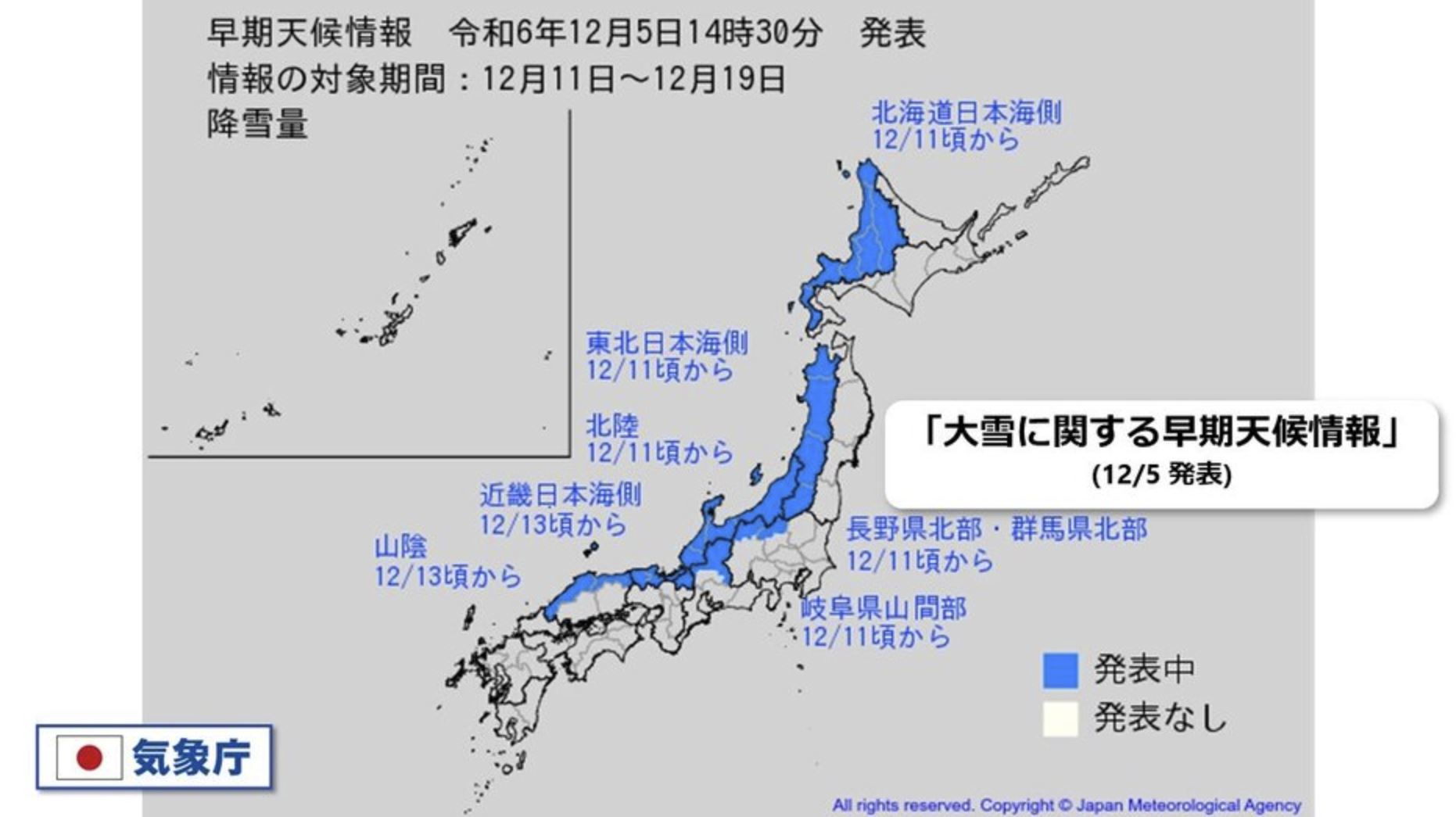Niseko Yotei Regional Kutchan Kosei General Hospital Announcement
Useful Tips from The Kutchan Kosei General Hospital

1.Please come to the hospital during regular consultation hours
- If you wish to seek medical attention, please come to our hospital during regular consultation hours. You can not make an appointment for your initial consultation. If it is a first visit, please come to the hospital directly, fill out the registration form and take it to the reception. Everyone is required to wear a facemask inside the hospital. We appreciate your understanding.
- A long waiting time can occur because patients with appointments are given priority. Therefore, please leave time to spare and come to the hospital early. Please let a nurse know beforehand if you must leave the hospital before a particular time. Please note that payment of medical expenses will be charged even if you cancel the consultation after medical tests or examination.
- We accept only emergency patients on weekends, holidays, and after regular consultation hours. If you wish to see a doctor outside regular consultation hours, please call the hospital beforehand and check whether it is acceptable. In addition, you may be consulted by a doctor other than a specialist for your symptoms, and you may be asked to visit again within regular consultation hours at a later date. The order of consultation will be decided according to severity so that you may wait for a long time. Also, please understand that limited drugs can be provided at ER.
2.Please bring an identification card
Please bring your physical identification card, such as a passport, driver’s license, residence card and produce it at the reception. We need to obtain your personal information, such as your name and birthday accurately. Patients with a Japanese national health insurance card must present it at the reception. If you do not have the card with you on the consultation day, pay the full amount by yourself and get a refund later.
3. About payment
You can pay the medical expenses by cash or credit card. (Debit cards are not accepted.) There is no international ATM inside our hospital. Therefore, please prepare some money before coming to the hospital, or bring a valid credit card. Cashless consultation using travel insurance is not available. If you have travel insurance, please pay the full medical expenses by yourself at the hospital and make a claim for the fee to your insurance company later. We can issue medical certificates for you but in Japanese only. If you need one, please tell your doctor that you need a medical certificate. (2,200 yen per certificate) Medical expenses may be expensive if you do not have Japanese national health insurance or travel insurance.
- Extra fees will be charged at the following time.6 am – 8:30 am and 5 pm – 10 pm on weekdays (nighttime charge)10 pm – 6 am on weekdays, Saturdays, Sundays, and public holidays (late night charge)6 am – 10 pm on Saturday, Sunday, and public holidays (holiday charge)
4.Note for Consultation
- Medicine can not be prescribed without a medical consultation with our doctor, even if you have a prescription from another doctor or are taking the medicine regularly. In addition, according to Japanese law, we cannot give you any medications, such as painkillers, before you see a doctor.
- Examinations such as MRI can not be performed without prior consultation with a doctor and his/her judgment. Therefore, you may need to wait for several hours or come back at a later date.
- We don’t arrange ambulances at the hospital. Please call 119 by yourself if it is needed. Since the number of ambulances in the area is limited, please REFRAIN FROM CALLING AN AMBULANCE if the condition is not severe or you can come by yourself with someone’s assistant. Please use a car or a Taxi if possible. Even if you come to the hospital by ambulance, you can not go back to your home or accommodation by ambulance. Please arrange a car or a tax by yourself for the return. (Taxies are not available between 2am to 6am)
- Psychiatric consultation is by appointment only. Please contact us by telephone in advance.
- We can not respond to telephone or email correspondence from overseas insurance companies. If they need any information from us, they have to contact a Japanese agent, and the Japanese agent to contact us for the information.
- English Interpreters are available between 8:30am – 6:30pm during winter. From 6:30pm until 8:30am, we have a videophone interpreter available. If you need an interpreter other than an English interpreter, we recommend you arrange an interpreter by yourself.
- Please follow the instructions of our staff while you are in the hospital. Please note that you may be asked to leave if you do not follow our instructions.
Niseko Yotei Regional Kutchan Kosei General Hospital
Higashi1-2,Kita4Jo,Kutchan-cho,Abuta-gun,Hokkai-do 044-0004 ,JAPAN
TEL: +81-136-22-1141
WEB: https://www.dou-kouseiren.com/byouin/kutchan/english/index.html
A Seasonal Gathering Spot: Niseko’s Winter Food Truck Park
A Seasonal Gathering Spot: Niseko’s Winter Food Truck Park

This winter, a new food truck park is set to become a vibrant addition to Niseko’s winter scene, offering an accessible and welcoming space for visitors and locals alike. Organized by Hokushin Catering and supported by Takuetsu Co. LTD., this initiative reflects a commitment to giving back to the community and addressing a pressing need during Niseko’s peak season.
Conveniently located just off the main street of Hirafu, the food truck park is easily accessible from the street next to Chalet Ivy, directly opposite The Maples Niseko. Its prime location makes it an excellent choice for skiers, snowboarders, and visitors staying at the higher end of Grand Hirafu’s main street, providing a perfect stop to recharge and refuel after a day on the slopes.
The food truck park was envisioned to solve the dining challenges faced in Niseko during the busy months of December to February, when securing restaurant reservations can be difficult. Featuring a variety of food truck options, it offers casual dining in a relaxed atmosphere that captures the lively and international spirit of Niseko’s winter.
This initiative operates independently of the Aki Niseko project, a luxury development by Takuetsu Co. LTD.. While Aki Niseko embodies exclusivity and sophistication, the food truck park celebrates community and accessibility, bringing people together over shared meals and experiences.
With its prime location, community-first approach, and thoughtful design, the food truck park is set to become a hub of warmth and connection, enhancing the Niseko experience for both visitors and locals.
Inquiries for this food truck pop-up should be sent to H2 Group.
2024 PropertyGuru Asia Property Awards
Outstanding resort projects, portfolios take centre stage at 2024 PropertyGuru Asia Property Awards (Japan)
SHOWCASING TOP-CALIBRE VILLAS AND HOMES, JAPAN’S PREMIER RESORT DESTINATIONS RISE TO PROMINENCE AT THE AWARDS
The 2024 PropertyGuru Asia Property Awards (Japan) today unveiled the finest developers, design firms, and portfolio managers from the country’s premier resort markets during an exclusive luncheon at The Athenee Hotel, a Luxury Collection Hotel, Bangkok.
H2 Life, part of H2 Group KK, was celebrated for the Best Property Management Portfolio, recognising its excellent range of completed projects throughout Japan.
Kisin by Yoichi Dreams dominated the awards, winning Best Resort Housing Development, Best Nature Integrated Development, and Best Resort Housing Architectural Design.
Grand Tsuru Niseko by Niseko Woodlands Limited was recognised as Best Boutique Resort Housing Development.
The Top Luxury Private Villa (Greater Niseko) award was jointly presented to Alba by Noforma Design Studio and Grand Tsuru Niseko by ABD Architecture LLC.
Niseko Woodlands Limited went on to win Best Housing / Landed Development (Asia) for Grand Tsuru Niseko at the 19th PropertyGuru Asia Property Awards Grand Final, held on the same day at The Athenee Hotel, a Luxury Collection Hotel, Bangkok. Yoichi Dreams also scored a victory at the Grand Final with the Best Resort Housing Architectural Design (Asia) award for Kisin.
Jules Kay, general manager of PropertyGuru Asia Property Awards and Events, said: “In Japan’s resorts destinations, local and international investors are launching developments that expand residential and lifestyle options for tourists and holiday home seekers alike. Beyond the winter season, these resorts offer year-round amenities and scenic natural attractions. Our awardees this year skilfully create spaces that seamlessly blend the best features of homes, hotels, and resorts. Congratulations to all our award winners in Japan.”
Eddie Guillemette, chairperson of the Awards, said: “Congratulations to all the winners of our awards in Niseko, Japan. Achieving these recognitions reflects the level of excellence in development, design, and service that captivates guests, sports enthusiasts, and investors in Niseko, Japan. We’re delighted to honour the finest projects in our resort market and celebrate exceptional craftsmanship that guides consumers on where to live, work, and play in this vibrant tourism hub.”
The independent panel of judges consists of Eddie Guillemette, CEO of Midori no Ki (MnK); Acme Wu, marketing professional for tourism and destination promotion; Bill Barnett, founder and managing director, C9 Hotelworks; Greg Hough, managing director, Niseko Portfolio and Explore Travel Group; and Minoru Okubo, representative director, ResortPropertyJapan Co., Ltd.
The selection process was supervised by Paul Ashburn, HLB International Real Estate Group. The official supervisor is part of the “2024 Network of the Year” winner HLB International, the global network of independent professional accounting firms and business advisers.
Organised by PropertyGuru Group, the 2024 PropertyGuru Asia Property Awards (Japan) are made possible by official portal partner PropertyGuru; official magazine Property Report by PropertyGuru; and official supervisor HLB.
For more information, email [email protected] or visit the official website: asiapropertyawards.com.
COMPLETE LIST OF WINNERS
2024 PropertyGuru Asia Property Awards (Japan)
PORTFOLIO AWARD
Best Property Management Portfolio
WINNER: H2 Life, part of H2 Group KK
DEVELOPMENT AWARDS
Top Luxury Private Villa (Greater Niseko)
WINNER: Alba by Noforma Design Studio
WINNER: Grand Tsuru Niseko by ABD Architecture LLC
Best Resort Housing Development
WINNER: Kisin by Yoichi Dreams
Best Boutique Resort Housing Development
WINNER: Grand Tsuru Niseko by Niseko Woodlands Limited
Best Nature Integrated Development
WINNER: Kisin by Yoichi Dreams
DESIGN AWARD
Best Resort Housing Architectural Design
WINNER: Kisin by Yoichi Dreams
PROPERTYGURU CONTACTS:
General Enquiries:
Richard Allan Aquino, Head of Brand & Marketing Services
M: +66 92 954 4154
E: [email protected]
2025 Rhythm Rail Jam
Rails, riders, and rad vibes: Rhythm Rail Jam is officially back!

Rails, riders, and rad vibes: Rhythm Rail Jam is officially back!
And we’re turning up the stoke for the biggest showdown yet!
This is a full-on shredfest celebration with ¥500k in cash prizes, live beats, food trucks, killer giveaways, and a charity raffle!
Oh, and the lineup? Groms, women, and men categories with the baddest riders throwing down mind-blowing lines, insane jibs, and rail riding that’ll leave your jaw on the floor.
Save the date: March 1st, 2025 at Sunsports Field, Hirafu!
Think you’ve got what it takes to throwdown at this year’s showdown? Sign up for Rhythm’s Rail Jam!
Sign up now through event website!
When: March 1st 2025
Where: Niseko Tokyu Grand Hirafu Freeride Park
Time: 1pm-7pm
Entry: FREE
Raffle Ticket: 500JPY/ Will be sold at our Niseko Rhythm Stores closer to date.
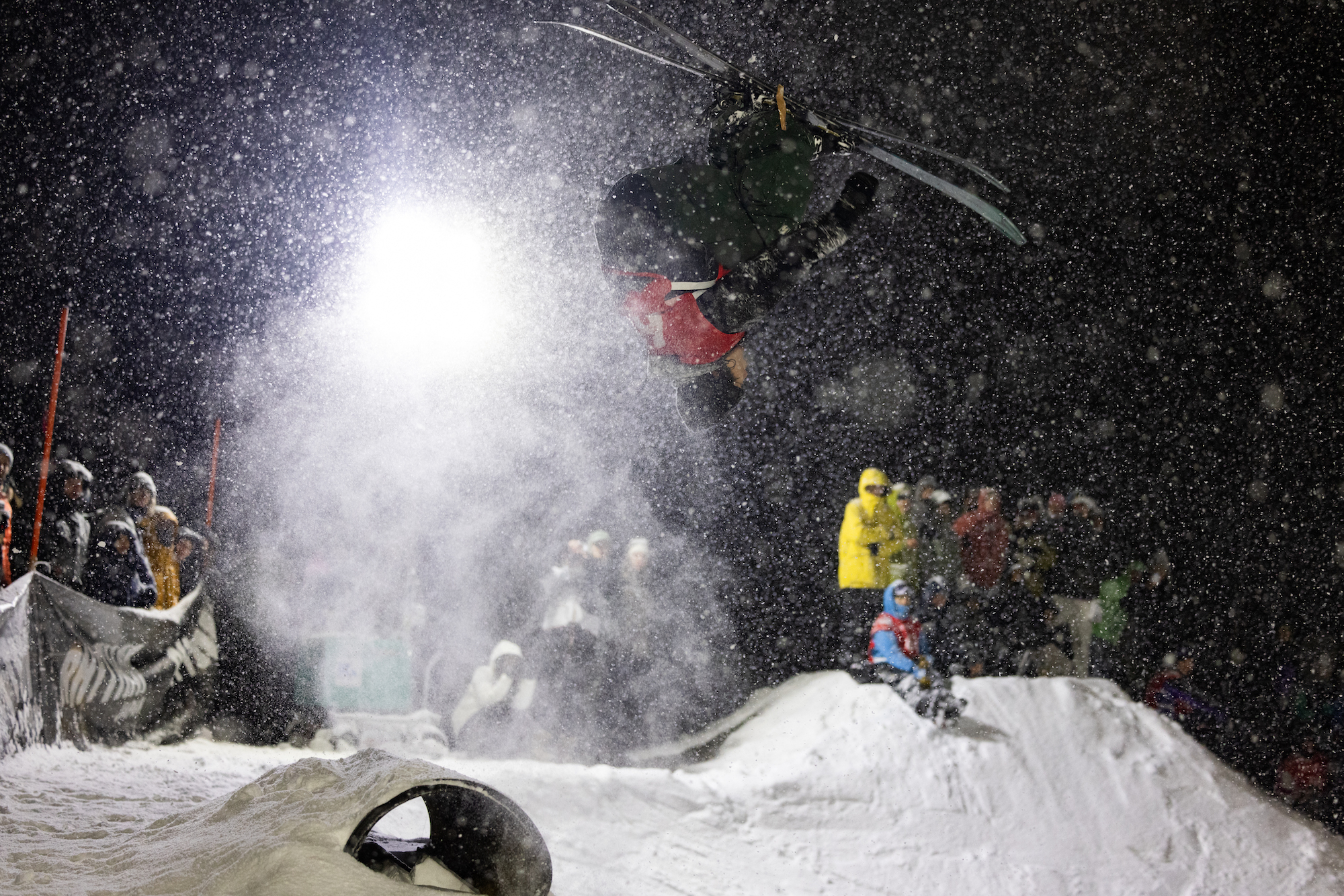


Established in 2005, Rhythm Japan offers everything customers need to embrace the ultimate mountain experience. Year-round lessons, guiding, retail, and rental offerings are paired with knowledgeable local staff who share their expertise and passion for unforgettable experiences. In Summer, the Niseko flagship store also serves as a community activity hub, featuring skate and climbing facilities, workspaces, and more.
Rhythm Japan is proud to be part of the evo family of brands. evo is a global outdoor retailer and experiences company with 11 evo stores in the U.S. and Canada, and global retail via evo.com. The evo family also includes travel and recreation businesses; evoTrip, evo Hotel, All Together Skatepark (Seattle and Salt Lake City), and Callaghan Country in BC Canada. Together, Rhythm and evo provide global access to experiences focused on sport, culture, the outdoors, and human connection.
To learn more about Rhythm Japan and their latest offerings for all seasons, visit www.rhythmjapan.com. Sign up for the newsletter and follow them on Facebook and Instagram to stay up-to-date.
General Inquiries
[email protected]
+81 136 23 0164 (JP)
+61 0 8002 0164 (AU)
How to Use an Onsen
How to Use an Onsen
How to Use an Onsen: A Beginner’s Guide
Soaking in an onsen is one of Japan’s most relaxing and culturally enriching experiences. To fully enjoy it while respecting local customs, it’s helpful to understand how to use an onsen the correct way. Here’s a guide to ensure your visit is both enjoyable and respectful.
Preparing for the Onsen
Start by purchasing an entry ticket, which usually costs between ¥500 and ¥1,500. If you didn’t bring towels, many onsen offer rentals. You’ll need two towels: a large one for drying off afterward and a smaller one to bring into the bathing area.
Remove any jewellery before heading into the changing area. The minerals in onsen water can tarnish metals or damage gemstones. Many facilities have lockers near the entrance where you can safely store valuables like your phone or keys. Once in the changing room, undress completely and place your clothes and large towel in a locker or basket. Be sure to leave your slippers in the changing area as they are not allowed in the bathing area. Bring only your small towel into the bathing area.
Washing Before Entering
Cleanliness is essential in Japanese onsen culture. At the shower stalls, wash your entire body and hair thoroughly. Onsen facilities usually provide soap, shampoo, and conditioner, but you’re welcome to bring your own products if you prefer. Make sure to rinse off all soap and shampoo, as the baths are meant for soaking, not for cleaning.
If you have long hair, tie it up to prevent it from touching the bathwater. This step helps keep the baths hygienic for everyone.
Entering the Bath
Onsen baths are typically heated to 39–42°C. Start by dipping your feet to adjust to the temperature before slowly immersing yourself. Keep your small towel out of the water—place it on your head or the edge of the bath instead.
While soaking, keep your movements gentle and your voice low to maintain the tranquil atmosphere. Many onsens have multiple pools, often with varying temperatures. Feel free to explore these at your own pace, but always enter and exit the baths quietly.
If the onsen has a sauna, you’ll usually find small foam mats near the entrance. Rinse one off with water and use it to sit on. After a sauna session, consider taking a quick dip in a cold bath to invigorate your body.
 Taking Breaks
Taking Breaks
Pay attention to how your body feels during your soak. If you start to feel overheated or lightheaded, step out of the bath and rest. Onsen bathing is best enjoyed in short, mindful sessions rather than staying in the water for too long.
Etiquette to Remember
Following onsen etiquette is an important part of the experience. Here are a few key points to keep in mind:
- Avoid bringing alcohol into the onsen. Drinks like beer are better enjoyed after your bath.
- Refrain from jumping into the snow or getting dirty between baths, as this is considered disrespectful.
- Leave slippers in the changing area and avoid bringing them into the bath zone.
- Photography and phone use are prohibited in the bathing areas to maintain the privacy of others.
- Some onsens may have tattoo restrictions. If needed, call ahead to confirm or use sports tape to cover tattoos.
After Your Onsen Experience
When you’re ready to leave, use your small towel to pat yourself dry before returning to the changing room. Once inside, use your large towel to dry off completely before dressing. Many onsen provide water stations to help you rehydrate, which is highly recommended after soaking in hot water.
If you’re waiting for friends or simply unwinding, relax in the lounge area, where you’ll often find vending machines with water, juice, or even beer.
Embracing the Onsen Experience
Taking the time to learn how to use an onsen properly allows you to fully immerse yourself in this cherished Japanese tradition. By following these tips, you can enjoy a relaxing and culturally respectful visit that leaves you feeling refreshed and renewed.
Summary
How to Use an Onsen: Quick Step-by-Step Guide
- Buy Your Ticket – Entry fees range from ¥500 to ¥1,500. Rent towels if needed.
- Prepare – Remove jewellery, store valuables in lockers, and undress completely. Bring only a small towel to the bath area.
- Wash Thoroughly – Use the provided showers to wash your body and hair. Rinse off all soap and tie up long hair.
- Enter the Bath Slowly – Start by dipping your feet and immerse yourself gradually. Keep your small towel out of the water.
- Relax Respectfully – Keep voices low and avoid splashing. Try different pools or use the sauna if available.
- Take Breaks – Step out if you feel lightheaded and re-enter when ready.
- Mind Etiquette – Avoid alcohol, snow jumping, and phone use. Check tattoo policies in advance.
- Dry Off and Rehydrate – Use your small towel to pat dry before heading to the changing room. Drink water to stay hydrated.
Follow these steps to enjoy your onsen experience while respecting Japanese traditions!
Niseko Bus Now Offering Tap-on, Tap-off Service
Niseko Bus Now Offering Tap-on, Tap-off Service
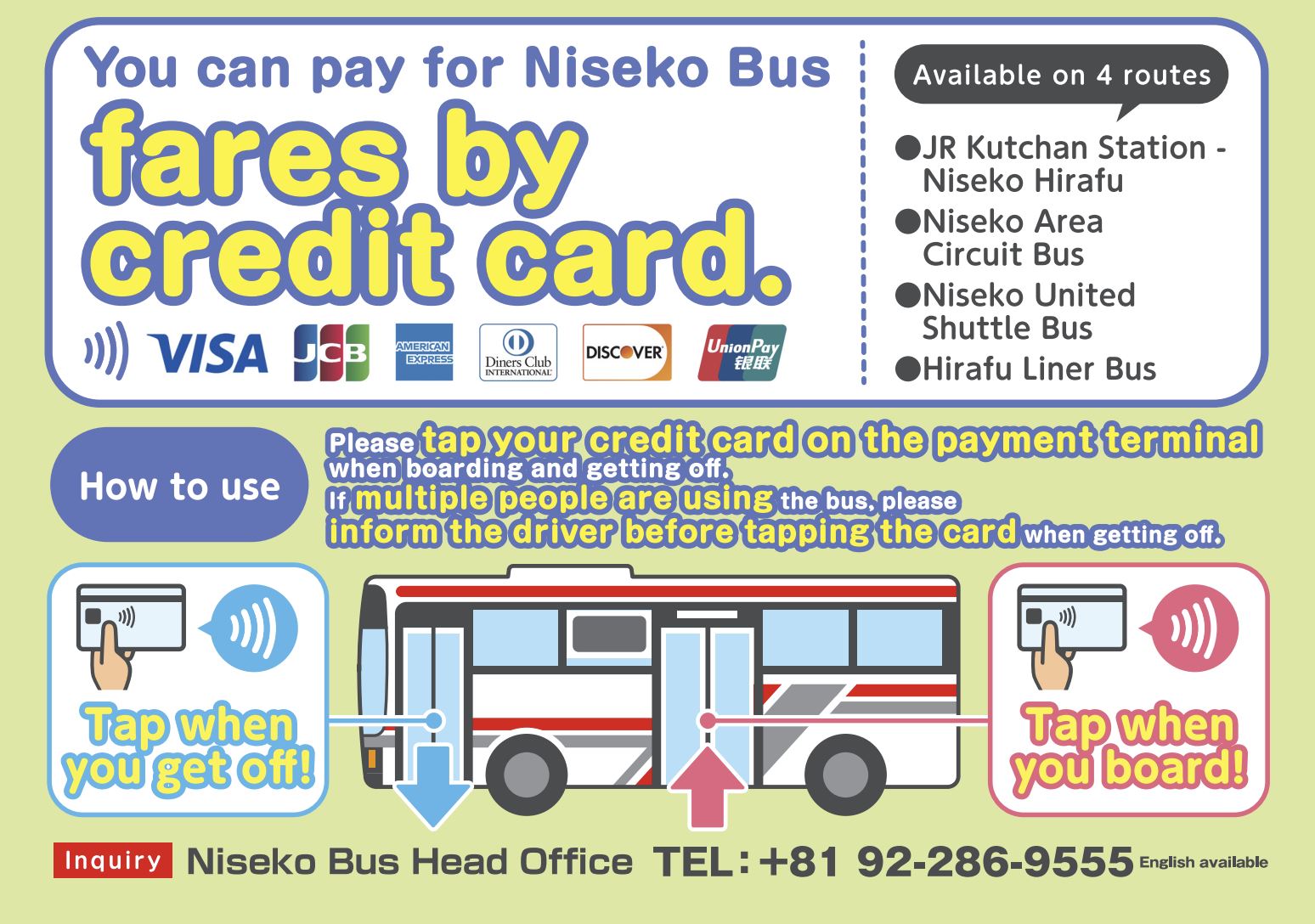
Niseko Bus has introduced a convenient tap-on, tap-off credit card payment system across its four main routes in the Niseko area, including the Niseko United Shuttle Bus. This new feature enhances the travel experience and streamlines public transportation for both visitors and residents.
To use the service, simply tap your credit card when boarding and again when disembarking. The system supports major credit cards such as Visa, JCB, American Express, Discover, and Union Pay. For group travel, notify the driver when disembarking, and the fare will be adjusted accordingly.
Additional Resources:
- For more details, check the official announcement HERE.
- Step-by-step instructions can be found in the PDF Guide HERE.
Contact Information:
Niseko Bus Co., Ltd.
Tel: +81-92-286-9555
Enjoy a smoother and more convenient way to travel around Niseko!
Park and Ride Project - Hirafu
Park and Ride Project - Hirafu

What is Park-and-Bus-Ride?
The “Park-and-Bus-Ride” system allows commuters to drive from their homes to designated parking lots and then transfer to public transportation for the remainder of their journey.
In the Niseko area, the easing of entry restrictions has resulted in an increase in international tourists, leading to significant issues such as traffic congestion and parking shortages due to the growing use of rental and private cars. With the anticipated extension of the Hokkaido Shinkansen and high-standard roads, traffic volume is expected to increase further in the coming years.
In the Hirafu area, measures are being implemented to reduce traffic volume, alleviate congestion, lower environmental impact, and promote the use of public transportation. As part of these efforts, the Park-and-Bus-Ride pilot program for employees, first introduced last year, will be conducted again in 2024.
Request to Business Owners
During the winter season, carpooling among staff is strongly encouraged. By late November, most parking lots in the Hirafu area are already full, primarily with staff vehicles, which are often occupied by only one person. Maximizing parking availability for guests is essential, and carpooling is an effective way to achieve this.
To further reduce congestion and environmental impact, carpooling with colleagues or even staff from other companies is recommended. Feedback on this initiative is welcomed to help improve its effectiveness as an important service for the community.
Implementation Details
- Period: Saturday, December 14, 2024 to Tuesday, February 11, 2025
- Location: 4-3-2, Niseko Hirafu, Kutchan Town, Hokkaido 044-0087
- Eligibility: Employees working in the Hirafu area
- Hours of Operation: 6:00 AM to 10:30 PM
- Fee: Free of charge
- Parking Capacity: Approximately 50 vehicles
Project Coordinated by Kutchan Tourism Association
TEL 0136-55-5372 FAX 0136-55-5376 Email [email protected]




Modern and stylish dormitory in Prime Kutchan location up for grabs!
Modern and stylish dormitory in Prime Kutchan location up for grabs!

Features and Highlights:
– Fully furnished rooms
– Single bed, Bench desk, closet, fridge, A/C, Kettle, Chair, Curtain, Counter Basin
– 17 rooms available for rent
– Communal bathrooms and toilets
Rates & Availability:
• Long-term: Annual leases or half year leases available, please contact [email protected] for more details. Tel: 070-9193-0613
Why us?
– Walkable distance to convenience stores, supermarkets, banks, post office, and hospital
– Perfect for ski schools, or short term workers in Niseko looking for convenience and privacy. Book now before they’re gone!
https://maps.app.goo.gl/MHxsuge24mngxNQPA

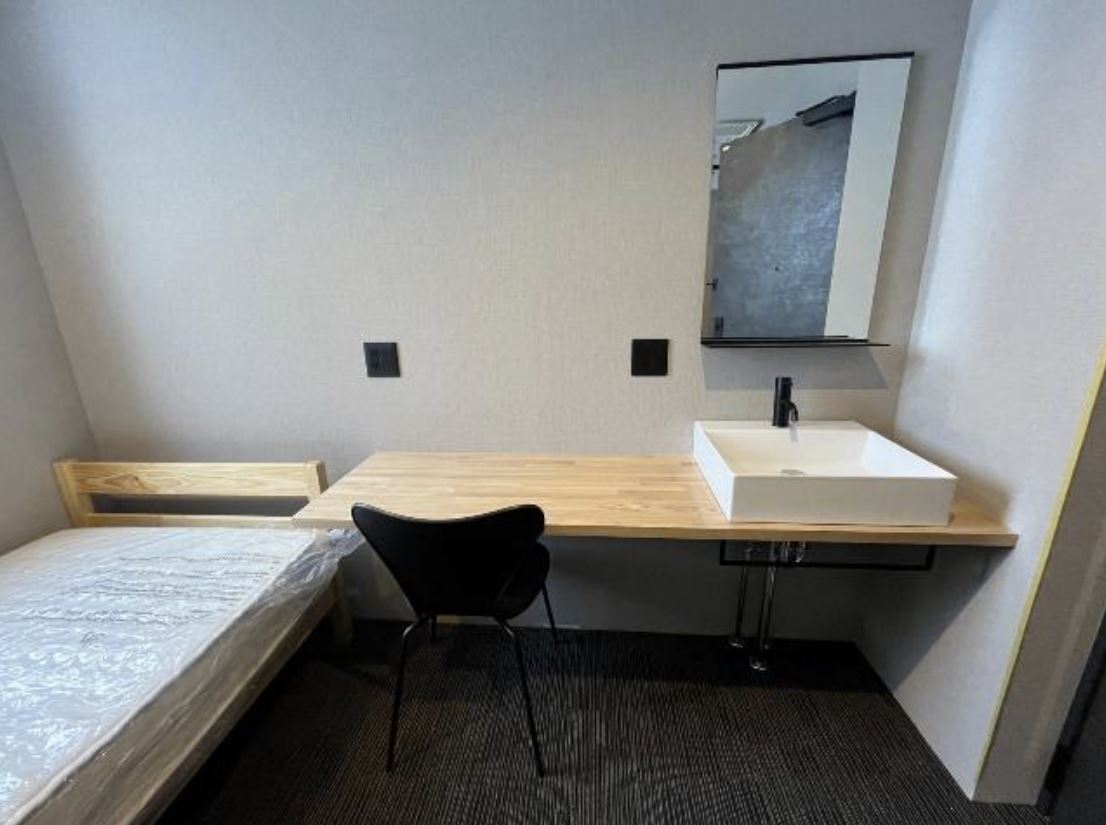

Enter To Win - 2024/25 Winter Survey
Enter To Win - 2024/25 Winter Survey

Prizes:
- Niseko United All Mountain Pass: Win a 2 Day Lift Pass at Niseko United for the 2024/25 winter season. Thanks to Niseko United.
- Park Hyatt Niseko Hanazono: Win a two night stay in a View King room with breakfast for 2 adults, valid from 15th March to 30th November 2025. Thanks to Park Hyatt Niseko Hanazono.
- SkiJapan.com: Win a weekend two night stay with SkiJapan.com during the summer season of 2025. Thanks to SkiJapan.com.
- Niseko Hanazono Resort: Win a session for two people to enjoy Tree Trekking at Niseko Hanazono Resort in 2025. Open from end of April to start of October 2025. Thanks to Niseko Hanazono Resort.
- Nikko Style Niseko HANAZONO: Win a one night stay at Nikko Style Niseko HANAZONO hotel. Prize includes a stay in a Superior Twin Room including breakfast for two people between March 15 to November 30. Blackout dates apply. Details below.
Terms and conditions apply to each of the above prizes.
By submitting an entry to this NPB Lucky Prize Draw, you acknowledge that you have read and agree to be bound by these Official Rules and the decisions of Niseko Tourism, and that you satisfy all eligibility requirements. Terms and conditions will apply to prizes.
If the survey does not appear for you above this line of text, please click here to complete the survey.
By entering into the draw you agree to sign up to the Niseko Tourism newsletter, and receive marketing communications from Niseko Tourism.
Prize Terms and Conditions:
Park Hyatt Niseko Hanazono Prize:
- Request is subject to availability. Offer based on availability valid from 15th of March 2025 to 30th of November 2025.
- Please make advance reservations with the Sales & Marketing office at [redacted] or [redacted] and
mention the voucher number on the front left. - Excluded during the Obon holiday period from Aug 13 to 16, 2025. please be sure to confirm its use in advance.
- The guest is responsible for any expenses incurred in addition to the services as mentioned above.
- Park Hyatt Niseko Hanazono is not responsible for theft, loss or destruction of this certificate.
- This certificate is not transferable, refundable or re issuable.
- Please present the voucher upon check in.
Nikko Style Niseko HANAZONO prize:
- Accommodation vouchers (Superior Twin Room)
- For 2 guests per room, including breakfast
- Validity: March 15 – November 30
- Blackout dates: April 26 – May 6, July 19 – 21, August 9 – 17, September 13 – 15
Niseko’s Once-in-a-Decade Blizzard is Coming!
Niseko’s Once-in-a-Decade Blizzard is Coming!
Niseko is renowned for its incredible snowfall, drawing skiers and snowboarders from around the globe. But even in this winter wonderland, there are rare events that stand out. The Japan Meteorological Agency have issued an announcement that a once in a decade snow storm is coming this 11 December 2024 and will persist until approximately the 19th. This blizzard is marked by strong winds, massive snow accumulation, and challenging conditions that demand caution and preparation from everyone in the area.
While a once-in-a-decade blizzard brings challenges, it also creates an unforgettable winter wonderland. The sheer volume of snow transforms the landscape into something straight out of a snow globe. For skiers and snowboarders, it means an unprecedented chance to enjoy Niseko’s legendary powder once conditions settle – fresh tracks on deep, untouched snow await those ready to embrace the adventure.
What Makes This Storm Different?
A typical winter day in Niseko is characterized by steady snowfall, light winds, and a magical powder experience on the slopes. The once-in-a-decade blizzard is a completely different beast. These storms bring:
- Heavy Snowfall: Rapid accumulation can overwhelm roads, paths, and rooftops, creating hazards in areas that are usually fine.
- Strong Winds: Strong winds can reduce visibility, and make it more difficult to walk or drive.
Safety Precautions for Walking and Being Outdoors
Even a short walk can turn into a challenge during a major storm. Snow piles up quickly, and strong winds can obscure familiar paths. Here are some essential tips to follow:
- Stick to Paths: Wandering off footpaths or roads is a bad idea during blizzards. It’s very easy to get lost, and snow-covered terrain can hide hazards like sudden drops, streams, or unstable surfaces.
- Limit Exposure: Avoid being outside for prolonged periods, especially in exposed areas. Frostbite and hypothermia become real risks when temperatures get low and wind chill rises.
- Beware of Snow from Roofs: One of the lesser-known but serious dangers during heavy snowstorms is the snow on rooftops. Accumulated snow can slide off suddenly, especially when the wind picks up or temperatures briefly rise. Avoid walking or waiting under eves or sloping roofs.
If you must go outside, ensure you’re dressed appropriately with layers that protect against the snow and wind, and keep essential items and a fully charged phone with you.
Driving During the Blizzard
Driving in Niseko during regular snowfall already requires caution, but during a once-in-a-decade storm, it’s best to avoid unnecessary trips. For those who must drive, follow these critical precautions:
- Ensure Your Vehicle Is Prepared: Snow tires are mandatory in Niseko, but even with proper equipment, ensure your vehicle has plenty of fuel, antifreeze, and a snow shovel on hand.
- Drive Slowly and Stay Alert: Visibility can drop to near zero in blizzards. Reduce your speed, increase following distances, and use fog lights.
- Check Road Conditions: Before heading out, check the latest updates on road closures or dangerous sections.
- Don’t Drive Unnecessarily: If your trip can be postponed, wait until the storm subsides. Emergency vehicles may need the roads, and staying off them reduces the risk for everyone.
On the Slopes: Skiing and Snowboarding During the Storm
While the allure of fresh powder can be tempting, skiing or snowboarding during a blizzard can be dangerous.
- Follow Resort Guidelines: The Niseko Rules cover lift closures and boundary restrictions. Never attempt to ski out of bounds during these conditions and never cross boundary ropes.
- Avoid Backcountry: Even with avalanche gear, the backcountry is highly unpredictable during a blizzard. Strong winds and heavy snowfall increase avalanche risks significantly. Even after the blizzard subsides, the snowpack can be unstable so wait for professionals to assess the snowpack.
- Wear Appropriate Gear: If you decide to ski, ensure your gear is up to the task. Goggles with good visibility, windproof outer layers and extra base layers, and a helmet are essential.
When the storm passes, Niseko’s legendary powder will still be there waiting. Until then, safety should come first.
 Why These Storms Are Memorable
Why These Storms Are Memorable
Once the storm subsides, it’s important to remember that conditions won’t immediately return to normal. Roads may still be covered, avalanche risks may remain high, and snow-clearing crews will likely be working overtime to restore access.
The rarity of a once-in-a-decade blizzard makes it an event locals and visitors will talk about for years. These storms are a reminder of Niseko’s untamed winter beauty and the importance of respecting nature’s power.


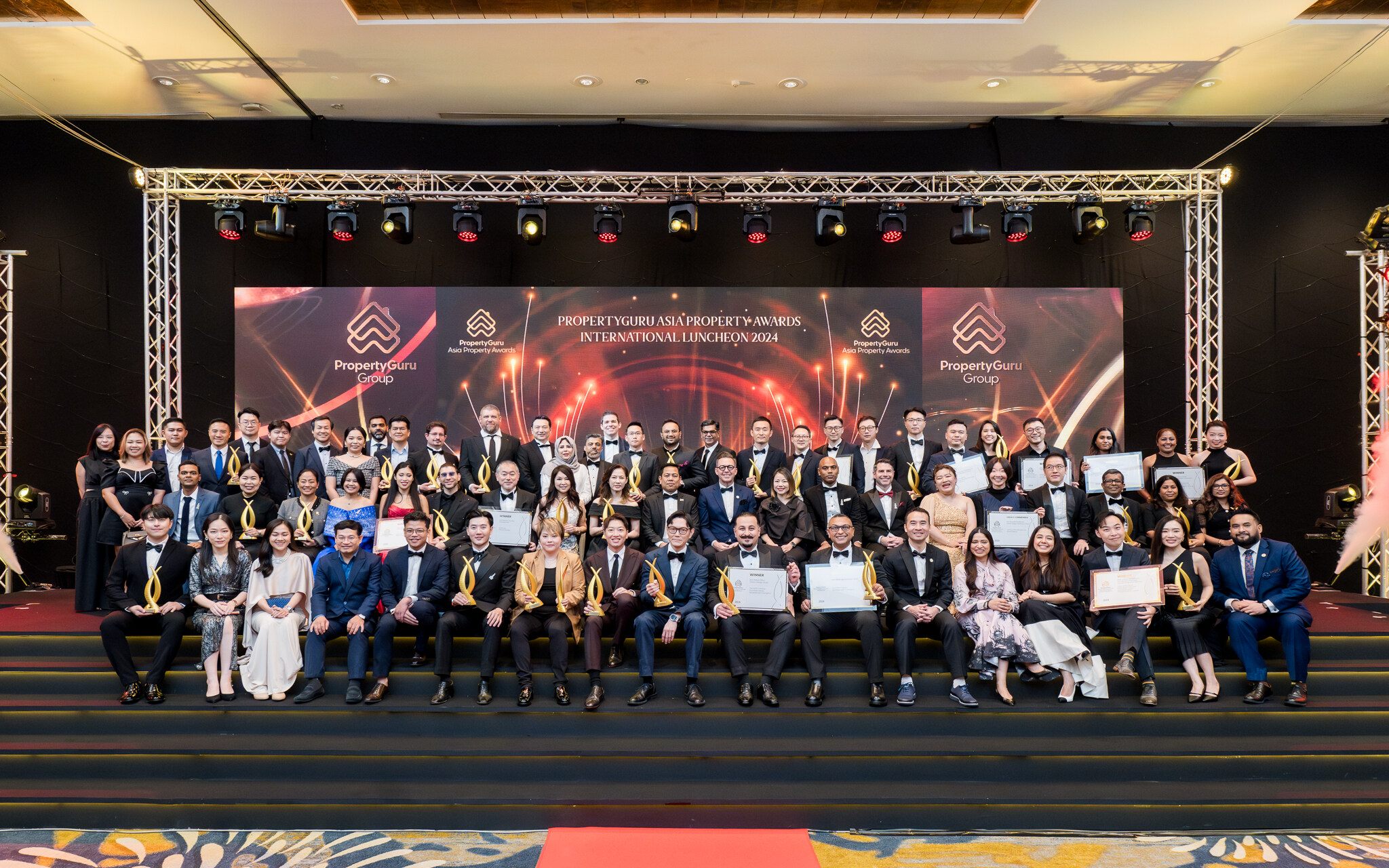










 Taking Breaks
Taking Breaks




